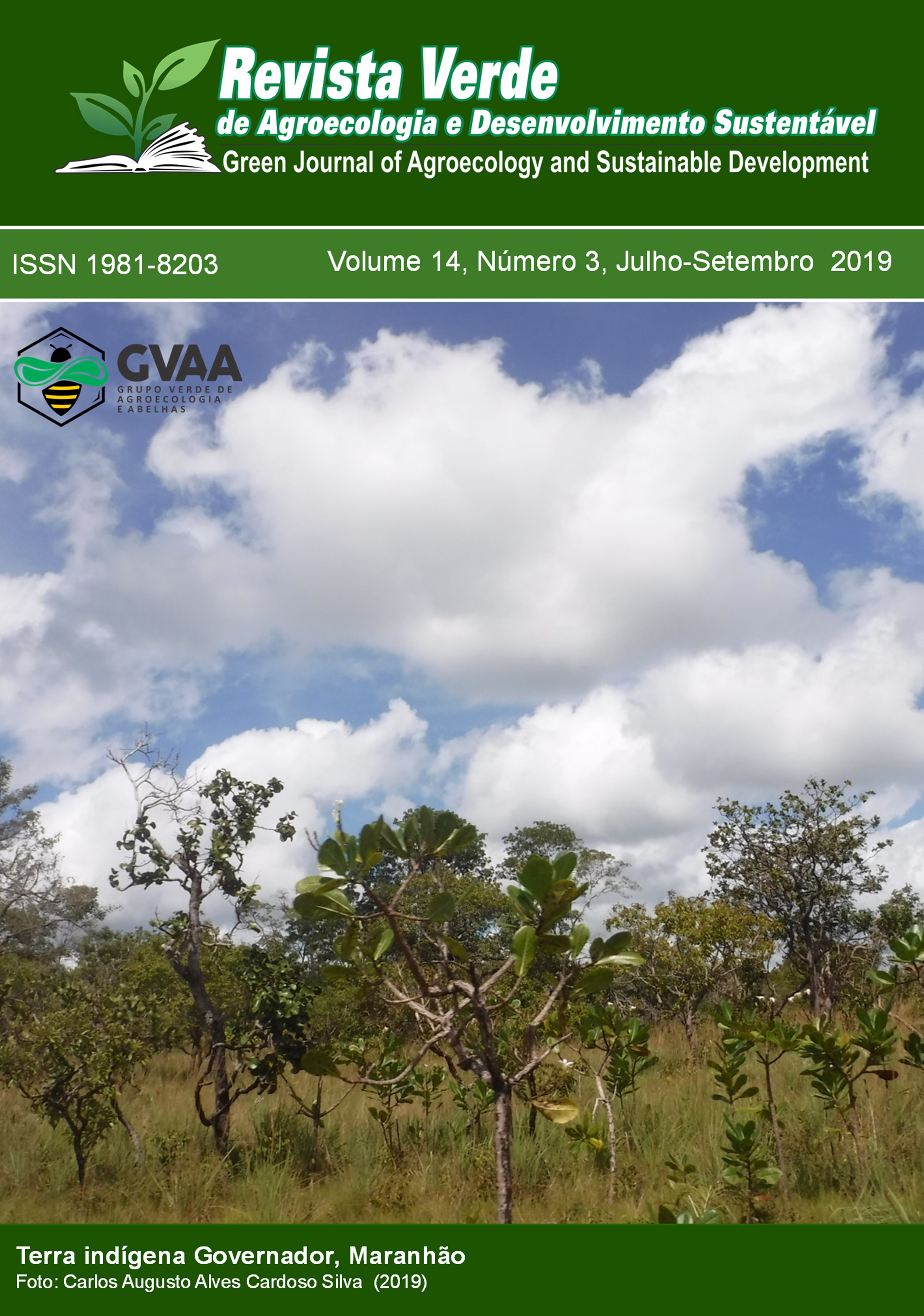Orange juice sensory with different sugars
DOI:
https://doi.org/10.18378/rvads.v14i3.6317Keywords:
Citrus, Brown sugar, Honey, Acceptance testAbstract
Brazil is the world's largest producer and exporter of orange juice. Orange juice is a complex product, formed by an aqueous "blend" of various volatile and unstable organic components, responsible for its taste and aroma, as well as sugars, acids, minerals, vitamins and pigments. However, due to the more acidic flavor characteristic of orange juice, many consumers use the use of "common" crystal sugar for their consumption, which may reduce the nutritional quality of the final product. Thus, the objective was to evaluate the acceptance of orange juice sweetened with brown sugar, honey, and refined sugar, by assessing the sensory perception of consumers. The work was developed at the State University of Rio Grande do Sul. The oranges of the Valencia variety, after selection, washing and sanitization were submitted to the juice extraction process manually, and after filtration, 4.5 liters of orange juice were collected. They were then separated into three 1.5 liter portions in three 2 liter containers each, and diluted with the addition of 0.5 liters of water and “ordinary” crystal sugar, brown sugar and honey to 14 ° Brix. The acceptance test was performed by a team of 31 untrained judges, and the orange juice was evaluated for its appearance, taste, acidity, sweetness and overall impression, using a structured hedonic scale evaluation form. Nine points. Orange juice sweetened with refined sugar was presented as the best option of the evaluators, presenting higher grades in all tested attributes.Downloads
References
CARDELLO, H. M. A. B; SILVA, A. A. P; DAMÁSIO, M. H. Análise Descritiva Quantitativa De Edulcorantes em Diferentes Concentrações. Ciência Tecnologia Alimentos, v. 20 n.3, p.15-18, 2000.
CARDELLO, H. M. A. B.; CARDELLO, L. Teor de vitamina C, atividade de ascorbatooxidase e perfil sensorial de manga (Mangifera indica L.) var. harden, durante o amadurecimento. Ciênc. Tecnol. Aliment., v. 18, n. 2, p. 211-217, 1998. 10.1590/S0101-20611998000200013
COUTO, C. A.; SOUZA, E. R. B.; MORGADO, C. M. A.; OGATA, T.; JÚNIOR, L. C. C. Cultivares de Citrus Sinensis: alternativas para a diversificação de pomares brasileiros. Revista Brasileira de Fruticultura., v.40, n.5, e-097, 2018. 10.1590/0100-29452018097
CORRÊA NETO, R. S.; FARIAS, J. A. F. Fatores que influem na qualidade do suco de laranja. Ciência e Tecnologia de Alimentos, v. 19, n. 1, 1999. 10.1590/S0101-20611999000100028.
DE FARIAS SILVA, C. E.; DA GAMA, B. M. V.; OLIVEIRA, L. D. M.; DE ARAUJO, L. T.; DE ARAUJO, M. L.; DE OLIVEIRA JUNIOR, A. M.; ABUD, A. D. S. Uso da laranja Lima e seus resíduos no desenvolvimento de novos produtos. Revista Brasileira de Engenharia de Biossistemas, v. 10, n. 1, p. 69-96, 2016. 10.18011/bioeng2016v10n1p69-96
ERPEN, L., MUNIZ, F. R., SOUZA MORAES, T., ROCHA T, E. C. Análise do cultivo da laranja no Estado de São Paulo de 2001 a 2015. Revista IPecege, v. 4, n. 1, p. 33-43, 2018. 10.22167/r.ipecege.2018.1.33
FAO. Food and Agriculture Organization of the United Nations 2017. Crops. Disponível em: <http://www.fao.org/3/a-i8092e.pdf>. Acesso em 10 jan. 2019.
GAVA, A. J.; SILVA, C. A. B.; FARIAS, J. R. G. Tecnologia de Alimentos: princípios e aplicações. São Paulo: Nobel, 2008.
IBGE, Instituto Brasileiro de Geografia e Estatística. Produção Agrícola Municipal – 2015. 2017. Disponível em: <https://sidra.ibge.gov.br/pesquisa/pam/tabelas>. Acesso em: 10 jan. 2019.
LEITE, I. F. S.; MOURA, T. C.; ALIXANDER, B. M. A.; PEREIRA, F. K.; FARIAS, F. G. Avaliação sensorial, microbiologia e físico-química de suco artificial de laranja adicionado de diferentes agentes adoçantes. Revista Verde de Agroecologia e Desenvolvimento Sustentável. v.11, n 4, p. 194-197, 2016. 10.18378/rvads.v11i4.4626
MANTILLA, S. P. S.; SANTOS, É. B.; BARROS, L.; FREITAS, M. Análise descritiva quantitativa aplicada em mel de abelhas (Apis mellifera): Uma revisão. Colloquium Agrariae,. p. 75-84, pp. 10.5747. 2012. 10.5747/ca.2012.v08.n2.a081
MARTINEZ, M. Laranja. Disponível em: <http://www.infoescola.com/frutas/laranja> Acesso em: 28 de agosto de 2017.
OLIVEIRA, D., GALHARDO, J., ARESC, G., CUNHAB, L. M., DELIZAA, R. Sugar reduction in fruit nectars: Impact on consumers' sensory and hedonic perception. Food Research International. 107, 371-377, 2018. 10.1016/j.foodres.2018.02.025.
PARAZZI, C.; JESUS, D.A.; LOPES, J.J. C.; VALSECHI, O. A. Análises microbiológicas do açúcar mascavo. Bioscience Journal, v. 25, p. 32-39, 2009.
PORTAL ACTION. Teste de Friedman. Disponível em: <http://www.portalaction.com.br/tecnicas-nao-parametricas/teste-de-friedman>. Acessado em: 28 de Agosto de 2017.
R CORE TEAM. R: A language and environment for statistical computing. R Foundation for Statistical Computing, Vienna, Austria. 2019. Disponível em: <https://www.R-project.org/>. Acessado em:
SILVA, R. A., MAIA, G. A., DA COSTA, J. M. C., RODRIGUES, M. D. C. P., FONSECA, A. V. V., SOUSA, P. H. M., e CARVALHO, J. M. Néctar de caju adoçado com mel de abelha: desenvolvimento e estabilidade. Ciência e Tecnologia de Alimentos, Campinas, v. 28, n. 2, p. 348-354, 2008. 10.1590/1981-6723.18916
SGS do Brasil. Análise sensorial. São Paulo. Disponível em: <http://www.meuspa.com.br/download/AnaliseSensorial.pdf> Acesso em 16 jan. 2019.
VILLANUEVA, N.D.M.; PETENATE, A.J.; DA SILVA, M.A.A.P. Perfomance of hibrid hedonic scale as compared to the traditional hedonic, self-adjusting and ranking scales. Food Quality and Preference, Oxford, v.16, n.8, p.691-703, 2005.













